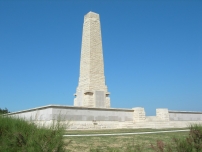| First Name: | Frank | Last Name: | LE BRUN | |
|---|---|---|---|---|
| Date of Death: | 14/08/1915 | Lived/Born In: | Wimbledon | |
| Rank: | Lance Corporal | Unit: | Hampshire8 | |
| Memorial Site: | Helles Memorial, Gallipoli | |||
Current Information:Age-27 115, Faraday Road, Wimbledon
Gallipoli 1915 On 25 April, British, Australian and New Zealand forces landed on the Gallipoli peninsula. The plan was that these forces would soon defeat a demoralised Turkish army, knock Turkey out of the war, open up the Mediterranean to the Russian navy and threaten Austro-Hungary from the south. None of these things were achieved despite nine months of hard fighting in terrible conditions. It was a heroic failure. By July, 1915, and after much fierce fighting, stalemate had set in at Gallipoli both at Cape Helles where the British and French had landed and at Anzac Cove where the Australian and New Zealand Corps were unable to break out of their beach head. Fresh troops were needed and they were on their way in the shape of four divisions from Britain and things were put on hold until they arrived. The plan for August was for a landing at Suvla Bay to the north of Anzac Cove whilst at the same time, the ANZAC Corps, reinforced by some of the new British troops would effect a breakout from Anzac Cove and establish a line across the peninsula. Whilst this was going on the troops in the south at Helles would stage a number of diversionary attacks. But it all went horribly wrong and much of the reason for this can be explained by inadequate planning and leadership. Nobody seemed to know what they were supposed to be doing and Lieutenant-General Stopford, in charge of the Suvla landings was particularly out of his depth. The landings at Suvla failed to link up with the forces at Anzac and the breakout from there did not happen despite valiant efforts by all concerned. The loss of life on all fronts was again enormous. L.A. Carlyon’s excellent book “Gallipoli” gives a superb yet chilling account of the events. The 54th Division was the last to arrive at Gallipoli, landing at Suvla Bay from 10th to15th August, 1915. 163 Brigade, which included the 8th Hampshire battalion came ashore at A Beach on 11th August and on the evening of 12th August began moving inland, to the north of Hill 10, an advance that ended in calamity. There had been no previous effort to reconnoitre the ground over which the attack was made and the enemy’s strength and dispositions were entirely unknown. The supporting artillery, not knowing where the enemy were was largely ineffective and orders concerning objectives were vague. After moving forward for half a mile across open grazing land that offered no cover, 163 Brigade began sustaining casualties from Kidney Hill to the north and also from the right flank, casualties that grew heavier as the advance continued. In fact, so heavy were the casualties that the advance faltered and came to a stop, except on the right where a large part of 5th Norfolk , accompanied by some of 8th Hampshire, continued going forward, but were never seen again and whose bodies were not discovered until 1919. Elsewhere, the survivors of the other battalions fell back to their starting line. Among the many casualties suffered by 8th Hampshire was Frank Le Brun. |
||||
| « Back to Search Results | ||||
| If you think any of the information shown here is incorrect, Click Here to submit your amends and comments | ||||




